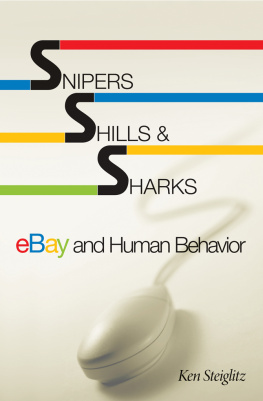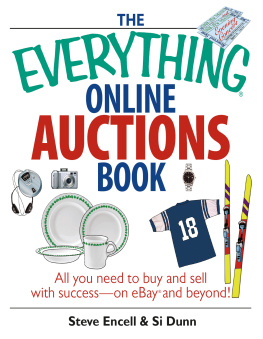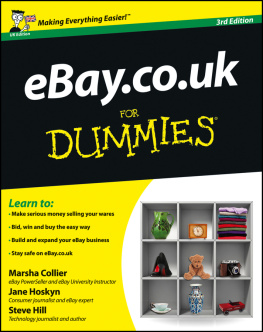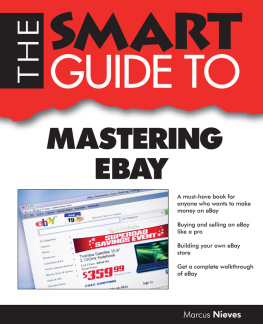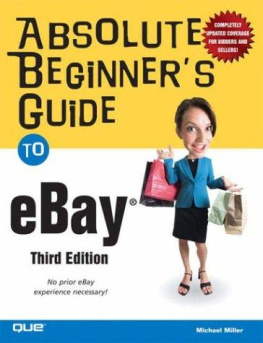SNIPERS, SHILLS, & SHARKS
SNIPERS, SHILLS, & SHARKS
eBay and Human Behavior
Ken Steiglitz
PRINCETON UNIVERSITY PRESS
PRINCETON AND OXFORD
Copyright 2007 by Princeton University Press
Published by Princeton University Press, 41 William Street, Princeton, New Jersey 08540 In the United Kingdom: Princeton University Press, 3 Market Place, Woodstock, Oxfordshire OX20 1SY
All Rights Reserved
Library of Congress Cataloging-in-Publication Data
Steiglitz, Kenneth, 1939
Snipers, shills, and sharks : eBay and human behavior / Ken Steiglitz.
p. cm.
Includes bibliographical references and index.
ISBN-13: 978-0-691-12713-2 (alk. paper)
ISBN-10: 0-691-12713-1 (alk. paper)
1. Internet auctionsSimulation methods. 2. Game theory. I. Title.
HF5478.S73 2007
381.177015193dc28 2006050389
pup.princeton.edu
eISBN: 978-0-691-23386-4
R0
To San
PREFACE
THIS BOOK is about the way buyers and sellers behave in auctions, especially internet auctions like eBay. Well discuss the empirical evidence showing how they do behave, the theory of how they should behave, and the continuing work towards understanding the very interesting differences. It is designed for two kinds of readers: the general reader, whom I picture as an active eBayer; and the student in an undergraduate course designed to cover the basic strategic ideas of auction theory and practice. No previous work in economics is required, and Ive arranged it so the mathematics is optional. Read on.
To the General Reader
I was first drawn to the study of auctions by my addiction to ancient coin collecting. In the 1980s and early 1990s ancient coins were available to the collector of small means largely through mail-bid sales, usually run by entrepreneurs who were collectors themselves, and who distributed simple, often mimeographed and unillustrated catalogs every few months or so. In their wisdom, the dealers ran the sales as what are now called Vickrey auctions, that is, sealed-bid, second-price auctions. When eBay arrived, it opened up an astonishing supply of low-priced and interesting items from around the globe, and attracted a corresponding clientele of collectors, some experienced and some new to the field. A second addictioneBayjoined my collecting habit, and, at the same time, I naturally became interested in auctions from a professional point of view as a computer scientist.
The buyer and seller behavior I observed was fascinating, and often puzzling. Some bidders bid early and often, some got in bidding wars, and some bid at the last second. Some sellers set opening bids of $0.01, some set enormous opening bids, some used inexplicable combinations of opening bids, secret reserves, and buy-it-now prices. The variety of behavior seemed endless. What forces were at play here, and how can the best thinking of economists help us understand them? These questions led me naturally to start a course on auctions, and this book grew from my course notes.
I was determined to keep the focus on observed behavior and the practical questions that arise constantly on eBay, and to combat a tendency to dwell on the mathematics. I therefore decided to write the main text with no mathematics at all; it contains, literally, no equations. However, I also wanted to give the general reader the option of working through the mathematical theory when it suited her. So for those who have some freshman calculus, I set down the elements of the most basic theory in three appendices. This gave me the luxury of invoking important results whenever I needed them, quite informally, but with the authentic mathematics close at hand for those who want to follow it, either on first reading or later. In the same way, I summarize the important results from the work in laboratory experiments with auctions in a fourth appendix, and refer to it at various points when it bears on behavioral questions. On the other hand, I discuss in the main text the recent and exciting empirical work based on eBay itself.
Most of all, I hope this book contributes to the readers enjoyment of the auction as a living, evolving institution, adapting to diverse environments: the tense uptown auction room, the friendly charity bazaar, the high-speed flower market, and, of course, the internet. Especially the internet, where the fierce and finely tuned eBay has enriched the lives of many people, from the thrifty small-timer turning some attic congestion into cash, to the full-time businessperson, to the eBayer so close to my heart, the obsessed collector.
To Students and Course Instructors
As mentioned above, this book can serve as a text for an introductory course in auctions. It emphasizes the importance of behavior, and uses the lively and familiar venue of eBay for its motivation and examples. What are these millions of people doing and thinking as they buy and sell the dizzying array of items every day on eBay?
The main text has no formal mathematics at all, no equations, no theorems, no proofs, and the main results of auction theory are stated and used in intuitive form. To see what the theory is like under the hood, the appendix contains three chapters that cover the main results of auction theory and prove them. The scope is limited to the optimal auctions of Riley and Samuelson for symmetric bidders with independent private values, and the corresponding generalization to asymmetric bidders by Myerson. The generalization of Milgrom and Weber to affiliated values is described briefly, as well as the very pretty application of Bulow and Klemperer showing that one extra bidder is worth more than arbitrary negotiating power. The elegant treatment of the theory by Krishna (2002) is a perfect source for more mathematical depth and breadth of coverage when needed.
The background of the clientele will determine how much of this mathematical theory can be covered in detail, but Ive found that the main ideas can be introduced naturally on an intuitive level, and the mathematics introduced gradually over a semester. When the students have a good working knowledge of freshman calculus, it should be possible to cover all of appendices AC. This will provide an introduction to most of the central ideas of auction theory: dominance, strategic equivalence, private values, equilibrium bidding, bid shading, revenue equivalence, risk aversion, common values, affiliated values, the winners curse, and the linkage principle.
A fourth appendix summarizes the literature in controlled laboratory experiments. When published field experiments are used, they are described in the main text. I also include the results of some of my own classroom experiments, anecdotally, for concreteness.
Synopsis
The gives a brief history of auctions in general, drawing on my own particular mania, ancient coins, for some examples of pre-eBay mail-bid sales. I then introduce the four standard auction forms, English, Vickrey, Dutch, and first-price, as well as the ideas of dominance and strategic equivalence.
shows how eBay can be considered the logical result of mail-bid sales moving to the internet.
is a survey of eBay behavior observed, with plots showing actual bidding histories for real items on eBay. Commonly observed strategies are identified and discussed, but with only passing reference to the theory.
poses the question: What if eBay were first-price? This is the most common question a newcomer asks, and leads to showing how the independent private value theory works in prescribing bid shading, and also introduces the concepts of equilibrium and revenue equivalence. I argue informally that eBay is second-price instead of first-price for a good reason: the first-price format discourages early bidding more, and early bidding is both profitable for the seller and fun for the buyer. Attracting bidders and bids is paramount.

